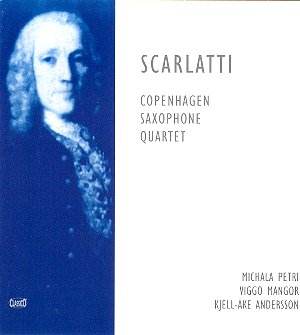This is a weird but very engaging CD. Make what
you will of saxophones playing Scarlatti, in the company of one
of the most brilliant and distinguished recorder players of our
time. Michala Petri needs no introduction; her fabulous technique
and musicianship would light up any recital, and it was an excellent
scheme to frame this off-beat collection with her unfailingly
stylish playing. She is an object lesson to any musician, and
most of all, of course, recorder players, in how to introduce
variety into 18th century music by the use of different
types of articulation. As soon as she sets off into the first
Allegro of K.90, you are borne along irresistibly by the
effervescence and restless energy of her playing.
The likelihood is that, while you are being carried
away by Petri’s virtuosity, you might not even have noticed that
she is being accompanied by a quartet of saxophones! The Copenhagen
Quartet are a model here of unobtrusive support, and blend quite
superbly with the baroque organ of Viggo Mangor. Having been ‘softened
up’ in this way, we are then treated to a whole sequence of Scarlatti
sonatas, originally for harpsichord, cunningly arranged for the
quartet. The playing is of the highest quality, though opinions
will vary as to the relative success of the different pieces in
this medium. The slower, more expressive numbers arguably do not
work as well, for the inherently louche character of the saxophone
tends to be only too evident. However, numbers such as K.30, the
wonderful ‘Cat’s Fugue’, or the hunting swagger of K.208, seem
to me to work like a dream.
What this recital does bring home is the sheer
wonder of the music; its lively wit, its unpredictability within
quite strict stylistic limits, and above all its amazing harmonic
resourcefulness - all of these make an enhanced impact when scored
out in this way. Naturally, one loses something when they are
moved from their natural métier, but there are enormous
gains, especially when they are performed as well as this.
One more little surprise is hidden away on track
9 in the form of an arrangement of K.8 in G minor for zink and
sax quartet. ‘Zink’ is the German name for ‘cornett’, and the
notoriously uncertain instrument is tamed superbly by Kjell-Ake
Andersson.
Unfortunately, no recording details are given,
that I could find anyway, other than the fact that organ continuo
player Viggo Mangor was also the producer of the disc. An unusual
but extremely rewarding musical experience.
Gwyn Parry-Jones
